Adam Yamey's Blog: YAMEY, page 89
May 12, 2023
Imported from India
IN THE FIFTEENTH century, the Portuguese made an important set of discoveries, which were kept a closely guarded secret. These discoveries brought great wealth to Portugal. The Portuguese navigators found routes from Portugal to India via the Atlantic Ocean and the Cape of Good Hope. By using these, they were able to transport spices and other valuable commodities from Asia to Portugal directly. Prior to the discovery of this sea route, goods from India and further east arrived in Europe via Egypt and the former Ottoman Empire. This overland route undoubtedly added various middle-man costs to the goods.
Once the Portuguese began sailing in the Indian Ocean, they successfully created a monopoly over trading in this area. However, after a period of uninterrupted use of the Indian Ocean, competition arrived in the form of mainly Dutch and British trading vessels.
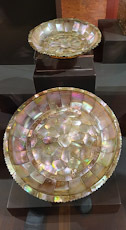 Mother of pearl bowls from India
Mother of pearl bowls from India Madeira was one of the places that the early Portuguese ships called in at during their voyages. This was brought home to me during a visit to Funchal’s superb Museum of Sacred Art. In two of its rooms we saw religious artefacts – sculptures and two mother of pearl bowls – which were labelled as having come from India. There were others that came from ‘Portuguese Asia’. One item, a beautiful inlaid tortoise shell box, came from Japan.
Unlike the religious sculptures we have seen in old Portuguese churches in Goa, which often feature Indian looking faces, those in the museum had European facial appearances. An exception is a 16th century carved panel depicting St Francis Xavier asleep on the Island of Shangchuang. He is accompanied by two saints – one Indian and the other Chinese.
Seeing these beautiful old sculptures and other objects, which were made in Asia and then brought to Madeira, helped make the history of Portugal’s former pioneering navigational achievements a little more vivid for me.
May 11, 2023
Franco and Franco in Funchal
MOST VISITORS TO central Funchal in Madeira will pass, and probably notice, a bronze statue high up on a square based plinth outside the Bank of Portugal and the Golden Gate Grand Café. It depicts Joao Goncalves Zarco, who began the Portuguese settlement of Madeira in the 15th century. Very few people who pass this statue will know that it was created by a Madeiran sculptor, Francisco Franco (1885-1955). His older brother Henrique Franco (1883-1961) is one of Madeira’s most famous painters.
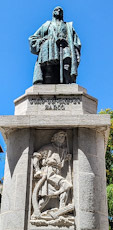
Both brothers studied at the Lisbon School of Fine Arts. They also spent time in Paris. Henrique returned to Madeira where he painted many of his pictures. Many of them are of Madeirans and scenes of the island. His paintings are beautifully executed and visually pleasing. Although the influence of Cezanne can be detected, Henrique did not seem to have affected by the innovative trends that were occurring in Western art during the 20th century.
Francisco visited Mussolini’s Italy in the 1920s and was impressed by the way that the state produced sculptures, which promoted the ethos and aims of the regime. He returned to Portugal, and began creating sculptural works that boosted the image of his country. Many of his important works were created for the Salazar government, which began in 1932.
Until our second visit to Funchal, I had never heard of the Franco brothers. Today, the 8th of May 2023, we visited a small museum in Funchal. It contains a fine collection of the works of both brothers. The museum contains many fine paintings by Henrique and sculptures by his brother, including a bust of Portugal’s former dictator Salazar. A video showing in the museum seems to suggest that far from being hostile to the Salazar dictatorship, Francisco was happy to create sculptures for it and its institutions.
Francisco attended an industrial school in Funchal. Its building is next to the museum. Over its main entrance is a carved stone sculptural frieze created by Francisco. The edifice now houses the Escola Secundaria de Francisco Franco, which opened in about 1976. Within its entrance lobby, we saw a bas-relief depicting the sculptor.
Although it is not one of Funchal’s main tourist attractions, the Museu Henrique e Francisco Franco deserves to be better-known.
May 10, 2023
Sensitivity
Hide your feelings
If they are likely to hurt others
Spare them the pain

May 9, 2023
Mahatma on Madeira
UNTIL AIR TRAVEL really ‘took off’, travelling between South Africa and London involved a long sea voyage, either via the Suez Canal or via the Atlantic Ocean. Boats carrying passengers up and down the Atlantic often called in at Funchal in Madeira. Aged three, I travelled with my parents to South Africa by sea. I have seen a photograph of me dressed in a toga made from a sheet from our cabin. I was taking part in a fancy dress party to celebrate crossing the Equator.
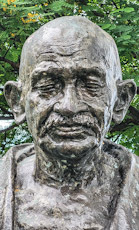
Many years before that – in 1906 – a barrister, Mohandas Karamchand Gandhi, travelled by ship from London to South Africa. He was on his way back to South Africa, having petitioned young Winston Churchill, then Under Secretary of State for the Colonies, against the Black Act – a law promoting racial segregation. Apparently, when his ship docked in Funchal, the future Mahatma received news that his efforts had been successful, but this news turned out to be false.
On the 5th of September 2019, a bust of Gandhi was unveiled on the seafront in Funchal, close to the harbour where liners dock today. The bust, which unusually shows Gandhi without his characteristic round lens spectacles, was sculpted by Ram Vanaji Sutar (born 1925 in Gondur, Maharashtra). Sutar is also the sculptor of the massive Statue of Unity, depicting Sardar Vallabhai Patel in Gujarat. Beneath the bust there is a quotation incorrectly attributed to Gandhi; it was actually said or written by the Dutch American pacifist AJ Muste (1885-1967). The artwork was unveiled by HE Miguel Albuquerque, President of the Regional Government of Madeira and HE Nandini Singla, Ambassador of India to Portugal. It celebrates the 150th anniversary of Gandhi’s birth.
I am grateful to our friend Claus for telling us about the bust, which is not easily visible despite its position so near the waterfront: it is partially hidden by plants.
Over the years, I have visited Porbandar where the Mahatma was born; Rajkot where he went to school; Bhavnagar where he went to college; West Kensington where he lodged when studying for the Bar; Mumbai where he attempted to work as a lawyer; and the Gujarat Club in Ahmedabad where he first met Vallabhai Patel, and also set up his ashrams. So seeing him on Funchal has added to my attempts to follow in his footsteps.
May 8, 2023
Islets on the island
MANY PEOPLE VISIT Madeira to improve their health or to retire. Some of these people die on the island and are buried there. Today (5th of May 2023), we took a look at the small English Cemetery in central Funchal. This well tended burial ground, founded in 1770, contains graves of British and some Portuguese people – Protestants mainly. In addition, there are graves of men and women born outside Portugal in places including Germany, Finland, Romania, USA, Holland, Sweden, and Poland.
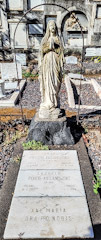
One of the Americans buried in the cemetery is Harry C Stone “Late Captain Cavalry USA”. His simple yet moving gravestone bears the date 1972 and the words:
“He believed in God”
Three graves particularly intrigued me. One of them marks the burial place of Lady Sarah Bonetta Davies (née Forbes). She was born in Ogun State in 1843 and died in Funchal in 1880. The gravestone informs that she was: “Princess of the Egbada Omoba people, West Africa. God-daughter of HM Queen Victoria.”
She was born an aristocratic member of the Egbada clan of the Yoruba people and was enslaved by King Ghezo of Dahomey, who ‘gifted’ her to Captain Frederick Forbes of the British Royal Navy. She became a god-daughter of Queen Victoria, and later married the Nigerian businessman James Pinson Labulo Davies of Lagos in West Africa. She died of tuberculosis in Funchal.
Another black African, George Oruigbiji Pepple, also lies buried in the cemetery. Between 1866 and 1883, he was the King of Bonny which was a small state in the Niger River delta. He was deposed in 1883 and restored to the throne in 1887. Why he was buried in Funchal , I have not yet discovered.
The third grave that interested me greatly is that of Paul Langerhans (1847-1888). This German pathologist and physiologist is best known for his discovery of the cells in the pancreas that produce insulin. Although he was unaware of the function of these distinctive cells, they have been named in his honour as The Islets of Langerhans.
Langerhans came to Madeira in 1875, having contracted tuberculosis. He recovered a little, researched marine worms, and practised medicine. In 1885, he married the widow of one of his patients. They lived together until his death. According to his wishes, he was buried in the English Cemetery in Funchal.
The cemetery is a lovely place to visit. It has plenty of flowers and is peaceful. On a future visit to Madeira, I would like to spend more time investigating the biographies of those whose remains lie there.
May 7, 2023
Blooms with a view
I AM ALWAYS WARY of ‘must see’ attractions because I dislike crowds and waiting in queues. So, last year when we visited Madeira, I thought it wise to avoid seeing the famous Botanical Gardens. In any case, most of Madeira’s capital, Funchal, is full of exotic plants and flowers – a veritable botanical garden in itself.
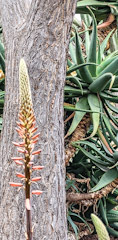
This May (2023), we decided to ‘bite the bullet’, and visit the Botanical Gardens high above Funchal. Getting there and back by local bus was easy. At the entrance to the Gardens, there was hardly any queue for tickets. And despite plenty of large tour buses parked nearby, the Gardens were not at all crowded.
Although I once owned a house with a 180 foot long garden in Gillingham, Kent, I am no gardener, and can hardly name any plant accurately. However, I love visiting gardens. The Botanical Gardens of Funchal are on the slopes of a hillside. All of the plants or groups of them are labelled. There are several terraces from which you can enjoy superb vistas of central Funchal, the sea, and the mountainous countryside.
The Gardens, which were opened to the public in 1960, are on land previously owned by William Reid, the founder of Funchal’s Reids Hotel. A bust in the garden commemorates Rui Vieira (1925-2009), a botanist who contributed much to the development of the botanical Gardens.
The highlight of the Gardens for me was a collection of mostly huge cacti, many of them bursting into flower. Everything else was also worth seeing in this well-kept, beautifully arranged garden. I am very glad that we visited this ‘must-see’ attraction on Madeira.
May 6, 2023
In search of WC on Madeira
IN JANUARY 1950, the famous writer, painter, and politician, Winston Spencer Churchill (‘WC’) paid a short visit to the island of Madeira with his wife and his eldest daughter. They were accompanied by various British officials.
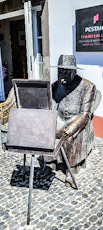
WC arrived on the island by sea, and stayed in the luxurious Reid’s Hotel in Funchal, which continues to flourish today. He left by seaplane a few days later to attend to affairs connected with an upcoming election in the UK.
While we were visiting the excellent photographic museum in central Funchal, we saw some photographs of Churchill, which were taken during his excursion to the picturesque fishing port of Camara de Lobos, which is a few miles west of Funchal. The photographs show WC painting a picture of the lovely bay surrounded by serried rows of houses. I have yet to see the picture, which I hope still exists.
We took a local bus to Camara de Lobos and disembarked close to a small bar named after WC. This is located close to a terrace overlooking the bay and its fishing boats. It was from here that he painted. A monument records this episode.
In 2019, a new hotel opened, the Churchill Bay. Outside its entrance, there is a sculpture depicting WC with cigar held between his lips. He is shown seated at an easel. Within the hotel’s lounge and bar, there is a fascinating collection of Churchilliana – photographs; letters signed by WC; a portrait by Felix Topolski; and contemporary artworks relating to WC.
Whether or not you are a fan of the Great WC, Camara de Lobos deserves a visit. Although there are plenty of tourists there, it manages to retain the feeling of a traditional fishing village.
May 5, 2023
Water from on high
WHEN THE PORTUGUESE first landed in Madeira in the 15th century, the area that they settled – the southeast corner of the island – it was not well watered. Using slave labour, they constructed a series of irrigation channels to bring water from the mountains to the drier area, where they later planted valuable crops such as sugar cane. These channels that snake their way gradually downhill along the mountainsides are called ‘levadas’. The construction of these channels continued into the early 20th century, when they were built by Salazar’s political prisoners.
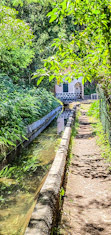
Today, the levadas continue to carry water and are well maintained. Paths run alongside each levada. Walking along them is a popular pursuit for tourist. Some of the paths are quite hazardous, and there are guided tours to shepherd groups of walkers safely along these waterside pathways.
We do not enjoy group tours. So, we had to find a levada that is not too hazardous and was easily accessible from Funchal. I homed in on the Levada dos Tornos, which passes under the hilltop village of Curral dos Romeiros – the terminal of bus number 29.
When we reached Curral, we asked the bus driver about the levada. He suggested where we proposed to walk was not good for us. We returned downhill in his bus, and he dropped us off at a staircase that led up toa section of the Levada dos Tornos, which he told us was not too narrow and led to a tea house.
We had a pleasant 3 mile walk along the levada, which wound its way gently downhill. All along the rout, lizards darted across the footpath as we approached them. Our way was lined with flowers and trees, many of them eucalyptus. Short stretches of the levada were shaded by bushes and trees. Other stretches provided views down wooded valleys. Sometimes, the port of Funchal could be seen far away and far below us. Most of the pathway was without hazards, but short lengths of it ran alongside sheer drops. Eventually, we reached the compound of the Jasmine Tea House, which caters for British tastes (cakes, scones, etc.) We did not have time to sample its wares because we did not want to miss the next bus (route 47) back to central Funchal.
Although we walked along a tame stretch of levada, we were able to gain an impression of Madeira’s remarkable network of irrigation channels.
May 4, 2023
Standing on a bench in Funchal, Madeira
ON THE FLIGHT FROM Stansted to Funchal, I sat next to a young man who was born in Madeira and now lives in the UK. He told me that we were just in time for the grand parade of the island’s annual flower festival. It would be happening on the afternoon of Sunday, the 30th of April (2023) at 430 pm, and that it always attracts large crowds.
At about 2.50 pm on the Sunday, we found an empty bench on the Avenida do Mar. This is a wide dual-carriageway that runs close to the seafront. Our bench was beside one of the carriageways. The parade was due to proceed along the other carriageway. By as early as 3 pm, people were gathering on the grassy divider that separates the two carriageways. They were between us and the route to be taken by the parade. More and more people assembled there, and we wondered how we would be able to see the proceedings.
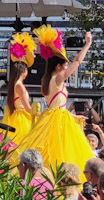
At about 3.30, an elderly English couple joined us on the bench. We did not speak with them until a few minutes before 4.30. Then, the rather frail looking old lady said to us:
“We’re going to stand on the bench to watch the floats pass by.”
I had thought about doing this but had been concerned about the stability of both the bench and me. But when this older lady and her even older husband climbed on the bench we joined them.
The colourful floats covered with floral decorations and lively girls and ladies moved a little faster than snail’s pace. They were separated by crowds of girls in folk costumes, who were singing and dancing as they proceeded. From our vantage point, we could see the floats easily, but the dancing girls were mostly hidden by the crowds on the grassy divider; only their headdresses could be seen.
After three floats had passed, the lady hopped off the bench, and said to me:
“We’ve got to go now. We don’t want to miss our team, Liverpool, playing.”
All this goes to show that one should never judge people by how old they look. Even some the oldest members of our species can be surprisingly full of life.
May 3, 2023
Places called London
MANY YEARS AGO, I used to visit Yugoslavia frequently. I stayed with friends in both Sarajevo and Belgrade. During almost every stay in Belgrade, several friends and I used to travel to the town of Novi Sad to eat good Chinese food in a restaurant called Szećuan. We used to order, and consume everything on its menu. This food was washed down with copious amounts of alcohol.
After one if these boozy lunches, we began walking to the railway station and as we passed a pub called Bar London, my friend Miša said to me:
“It would be surrealist if you take us for a drink in this bar”.
We had one or more ‘for the road’, and then staggered towards the station.
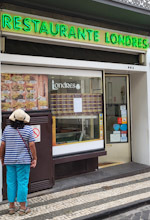
This memory was aroused by coming across the Restaurante Londres in central Funchal (Madeira). We ate dinner there. The food was excellent. For the first time in my life, I ate limpets. These aquatic snails were grilled in their shells with butter and garlic – they tasted wonderful. The other dishes we tried were so good that we have booked there again.
Returning to the past, if I recall correctly, there was also a restaurant or bar called London in central Belgrade, but oddly I never entered it.



